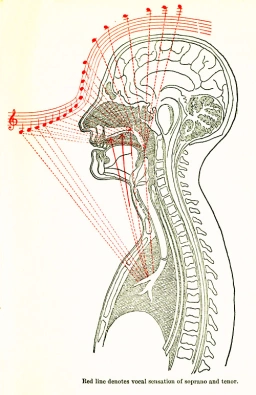Matt Edwards
Associate Professor of Voice, Shenandoah Conservatory Artistic Director of the CCM Vocal Pedagogy Institute
Mix it up Monday: The “forward placement” chart
In the early days of voice pedagogy, voice teachers were desperately trying to find ways to communicate how they sang to their students. These teachers were working before we had scientific tools available to develop fact-based teaching methods. One popular approach for teaching was the use of voice placement charts such as this from Lilli Lehmann’s book “How to Sing.”

While some singers may find these charts useful, for many others trying to place the tone can be detrimental to vocal development. Richard Miller explains why in his book “Solutions for Singers.”
“Much subjective terminology directed to resonance perception is less than utilitarian, because perception of sensation is such a highly individual matter. ‘Forward placement’ is one such term. Sympathetic vibration during singing varies greatly from person to person; to expect everyone to experience the same thing is unwise.” (Miller, p. 81)
If you are not familiar with the term, “sympathetic vibration,” here is a definition from Dr. Matthew Hoch’s “A Dictionary for the Modern Singer”:
“In acoustics, the phenomenon that occurs when a passive vibratory body responds to external vibrations. In singing, sympathetic resonances are sometimes subjectively felt in the singer’s body in areas beyond the vocal tract resonators” (Hoch, p. 172-173).
Richard Miller says you can experience sympathetic vibrations on a piano if you place your fingers on the music stand portion while the instrument is being played. While the music stand vibrates, it could be removed from the piano and there would be no noticeable change to the instrument’s timbre. This is because the music stand’s vibrations are sympathetic only, they are not part of the instrument’s resonator. Hard surfaces such as wood and bone are ideal for transferring sympathetic vibrations, which is why singers are often aware of vibrations throughout their face and skull when singing (Miller, p. 69).
Miller goes on to say:
“It is not possible to literally place tone. Yet sensations for some singers are registered in specific parts of the body, one being the region called the mask, or masque. However, similar mask sensations can be generated by a variety of physical means, some desirable, some not. Certain forms of sympathetic vibration in the mask actually are the product of undesirable timbres. Problems often are exacerbated when the singer is told to place tone. Responses to tone-placement requests frequently generate unwanted by-noises, nasality, pharyngeal distortion, localized control, and breathy timbre. After a tone that exhibits ideal resonance balance has been identified, it is then appropriate to ask the singer to describe the recognizable differences among the several kinds of sensation experienced, including their location.
Significantly, improved sound often emerges when the attempts at forward tone placement are abandoned. The teacher may hear from the student “but now I’m not putting it anywhere!” Yet the resonance balance shows remarkable improvement. The best way to build on the singer’s proprioceptive response to sympathetic vibration is to avoid confusing the sensation of tone with its actual source. Many problems that continue to plague even advanced singers stem from previous attempts to put tone in some precise spot or slot. Sound does not work that way.
There are many ways to discover identifiable sensations without inventing either acoustics or physiology. Do not ask any student to place tone forward, back, down, under, up, over, or up and over, because such actions are not possible. Instead, make certain that buccopharyngeal resonator shapes properly match laryngeal configurations. As students systematically work through resonance building exercises, they discover their own resonance sensations. If a singer feels the tone is now “forward,” excellent! I personally have a great deal of vibratory sensation in the frontal regions of my face, but not as a result of trying to put tone there. The singer will develop his or her own imagery after experiencing the presence of sympathetic vibration that results from efficient resonance balancing.” (Miller, p. 81-82)
Pedagogues other than Richard Miller have also described problems associated with forced sensations of forward placement. Robert Caldwell and Joan Wall, authors of “Excellence in Singing, Vol. 2” write:
“When you teach resonance, you need to discover what sound or kinesthetic sensation your student has in mind and then help her sort out her sensations and the corresponding sounds by giving her precise feedback. Always appreciate that your student’s sensations are subjective: the words that correspond to your sensations might not correspond to hers. Stop using the word immediately if your student has a different one that she uses. The point is to get her to develop her own system of remembering and accessing sensations. Use your eyes and ears rather than words to test whether she has reached the desired resonance.” (Caldwell & Wall, p 208-209)
In his book “The Free Voice: A guide to natural singing,” Cornelius Reid says:
“Early tradition had the right answer, because the Tosis, the Mancinis, the Lampertis, and the Garcias knew that by establishing a properly balanced registration through adroit use of pitch and intensity they could awaken correct symptoms of vibration. Contemporary instruction is remiss because it persistently attempts to establish a correct functional arrangement without regard for mechanical principles. To suggest ‘placing the tone high,’ ‘to sing forward,’ or to ‘get the tone up and over,’ will never improve the response patterns of the laryngeal muscles involved in phonation. Ends are not means.” (Reid, p. 35)
Meredith Bunch Dayme, author of “Dynamics of the Singing Voice” states:
“While it would be comforting for singers and teachers to find such a definite place as the nose or a particular sinus where the sound could be placed each time one sang, the fact remains that every singer is physically unique, therefore each singer has to develop (by trial and error and help from his teacher) his/her own set of clear, reproducible sensations in order to stabilize the vocal technique.” (Bunch Dayme, p. 143)
W. Stephen Smith, author of “The Naked Voice: A wholistic approach to singing” writes:
“Because we can change the shape and size of our primary resonators, it might seem as though we could manufacture resonance. However, resonance is always passive. It is a response to another vibration – it is something that just happens, not something we do. We seem to be able to make resonance happen in a specific place and are therefore lulled into thinking that it is active rather than passive. This concept is often referred to as placement, meaning we are putting resonance in a specific place. However, the nature of resonance is passive response and can’t really be placed anywhere.” (Smith, p. 16-17)
In his book “Kinesthetic Voice Pedagogy,” Kenneth Bozeman says:
“The acoustic sensation of a sung tone is comprised of various facets, resulting in part from it being composed of several formants, each of which create standing waves at different frequencies and therefore vibrational foci at various locations along vocal tract. In addition to vocal tract sensations are those that result from considerable bone conduction of vibration in the head, neck and even in the chest wall. The singer’s perception of tonal sensations will therefore be due in large measure to the facet to which their mind is attending. Sensitivity to vibratory sensations and bio-feedback also varies from singer to singer. These acoustic sensations change dynamically with change of pitch across the singer’s range. Furthermore, they interact with kinesthetic sensations of anatomic shape, position, or posture of the vocal tract. The complexity of the sensory signals necessitates flexibility, ongoing discussions with and feedback from the student, and avoidance of dogmatic insistence in the use of specific “placement” or other sensory imagery.” (Bozeman, p. 46)
In conclusion, while some students may find placement charts such as the one above useful, many others will not. If you are getting good results with all of your students using placement terminology – great. However, if a student fails to respond, it is likely because their perceptions of resonance are different than yours or the creator of the charts they are using. For those students, focusing on vocal function will yield much better results than continuing to force the voice into a place it does not want to go. If you feel like your description of placement is not working for a student, try making adjustments to the vocal folds and vocal tract instead. When you get the sound you are looking for, ask them what they are experiencing; the answer may surprise you. They may describe a sensation of placement or they may give you a color or aural description. It is also very possible that they may say the sounds is going out of the back of their head while to you it appears to be coming through the mask. Take note of what the student experiences and use it. You will likely be surprised how quickly they progress compared to when they attempt to force another singer’s placement on their body.
I am sure this post will stir a lot of conversation on the blog; you may post your comments below and respond to others as well. If you are not already following the blog, you can sign-up on the bottom of this page to receive an email every time there is a new post. If you enjoyed this article, please share it on social media. As always, thank you for reading.
~Matt





Very well stated and supported. Thank you Matthew!
LikeLike
Thanks for reading Teri! ~ Matt
LikeLike
I really, really wish we could get teachers on board with your second to last paragraph. So many teachers will swear that some trick of theirs is “never fail” and then comes the student for whom it doesn’t work. Guess who is blamed for the failure? “It should feel as if…” needs to disappear from teachers’ vocabulary.
LikeLike
In my zeal to speak my piece, I neglected to say that I think this is a very valuable article!
LikeLike
Thanks Brian! Maybe between our two blogs one day the message will finally be spread to enough people to affect change. Thanks for reading. ~ Matt
LikeLike
Thank you for filling out this discussion which was started a few days ago on The Professional Voice Teacher’s Facebook Forum. A teacher posted this exact chart as helpful to her and her students. I could not believe my eyes, although I am glad she found something that spoke to her. The very first pedagogy programs in the US used to use this chart as a guide. There may be a reason it is not used any more, although it is useful for pedagogy history.
LikeLike
You are welcome. Yes, this topic began on the Professional Voice Teacher’s page on Facebook. This is a discussion that needs to be had, I just want to make sure it is clear that this is not “against” that particular teacher, which is why that thread is not mentioned. Sometimes the forum can become very adversarial and I do not want to fuel that fire. I saw a chart similar to this come home from a local choir teacher recently. Since it surfaced in my life two times in the past two weeks, it seemed like a worthy topic. Thanks for reading Cate! ~ Matt
LikeLike
Great!
LikeLike
Rich terrain! I did my thesis on this topic because ‘placement’ was something elusive to my singing. I conducted a survey that went around the world and found absolutely no statistic – everyone has their own variations.
LikeLike
Not sure why my name was cut off. Jeremy
LikeLike
Great article Matt! My comment on the Facebook page was “This is an extremely useful chart if you are Ms. Lehmann. For anyone else, it should simply be a fascinating artifact.” It goes along with Miriam Arman’s fanciful illustrations in her book “The Voice: a Spiritual Approach to Singing, Speaking and Communicating”.
Cheers,
Craig
LikeLike
All I can say is, ‘Preach!’ This is a very astute description of the struggle so many singers face. And you have done so without calling out anyone’s individual approach. Yet, it’s clear this discussion is beginning to take root.
For so long, I felt it prudent to keep quiet in certain circles when “proper” approaches were being discussed. I’m delighted we’re beginning to discuss freedom, efficiency and resonance balance – not placement – and a teaching language that is geared to the experience of the student.
Kenneth Shaw
LikeLike
Hi! Thsnks.
LikeLike
Hi Matt,
Terrific article! I think sometimes people use ideas of placement because it is a shorthand of sorts, with a lot of catchy sentences and phrases that we have all heard. I know this might sound reductive, but I was wondering if you can offer a few directions/descriptions/images you find you often rely on to help people work on the same issues in a more productive and true-to-function way. Thanks for any thoughts! And again, I really appreciate your article! Emily
LikeLike
I agree on the shorthand, and if it works for a student great! I talk with my students about registration (chest, chest-mix, head-mix, head), vowels (bright and dark), and intensity (loud, soft, etc.). Vowels are often where troubles arise, so we talk about tongue and lip position as well as jaw opening. When we are talking about registration, I also talk about airflow. So if a student’s voice is “too dark,” I listen for what is happening at the vocal fold level, the back room (behind the hump of the tongue) and the front room (in front of the hump of the tongue). Common causes of darkness in the backroom would include a depressed larynx or retracted tongue. In the front room, the jaw may be over-extended or the lips protruded. I begin with what seems to be most apparent and give specific instructions (i.e. arch your tongue forward, smile, don’t try to lift your soft palate, etc.). When the student achieves the sound we are looking for I ask them “what is that?” I then use the language they use to coach them. If they say it is more forward, then we go with it. If they say it is more orange, I ask them for more orange. Does that help? ~ Matt
LikeLike
This is so terrific and helpful. Thanks for taking the time to reply. I’ll be thinking about all this in my teaching, and really appreciate the inspiration to constantly refine and reflect upon pedagogy. Thanks again!
LikeLike
This is interesting. I learned to belt with Jan Sullivan’s Phenomenon of the Belt/Pop Voice which focuses a lot on secondary resonances. So I’ve been using manipulating resonators (and teaching this way) for years…but I have always asked what things feel like to the students. I focus a lot on what the students feel when it is “working” and adjust from student to student. Since the training this summer, I have been focusing more on what’s happening on the vocal fold level. Some students really connect to one more than the other, in conjunction seem to really work because they connect to students in different ways.
LikeLike
Really enjoyed your article, thanks.
LikeLike
An excellent article and so very valid. Thank you for posting.
LikeLike
Very interesting and useful. Please notify me each of your articles!
Thank you!
LikeLike
Pingback: The "Forward Placement" Chart | Break A Leg Network
Great article!!
LikeLike
Many thanks for your sharing of insights.
LikeLike